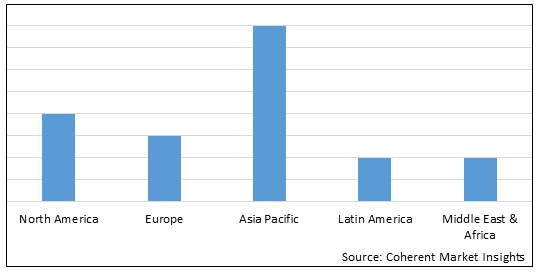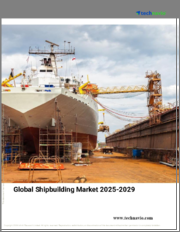
|
시장보고서
상품코드
1391897
조선 시장 : 유형별(여객선, 상선, 해군(수상, 잠수함)), 오프쇼어(FPSO/FSO, 오프쇼어 보급선), 지역별Shipbuilding Market, By Type (Passenger, Merchant, Navy (Surface, Submarine), Offshore (FPSO/FSO, Offshore Supply Vessel), And By Geography |
||||||
조선업계는 현저한 성장을 달성하고 있으며, 2023년의 세계 시장 규모는 약 1,497억 6,000만 달러에 달했습니다. 예측에 따르면 2030년까지 이 시장은 약 1,916억 7,000만 달러로 확대하며, 2023-2030년 CAGR은 약 3.6%에 달합니다.
| 리포트 범위 | 리포트 상세 | ||
|---|---|---|---|
| 기준년 | 2022년 | 2023년 시장 규모 | 1,497억 6,000만 달러 |
| 실적 데이터 | 2018-2021년 | 예측 기간 | 2023-2030 |
| 예측 기간의 CAGR | 3.60% | 2030년 시장 규모 예측 | 1,916억 7,000만 달러 |

세계의 조선 시장 규모는 2022년에는 1,466억 8,000만 달러에 달했습니다. 조선은 조선소로 알려진 전용 시설에서 선박이나 부유식 선박을 건조하는 것을 말합니다. 조선은 바다와 바다를 가로질러 화물과 승객을 운송하는 상업용 선박을 설계하고 건조하는 첨단 엔지니어링 및 가공 기술을 포함합니다. 세계화의 진전은 국제 무역 증가를 촉진하여 석유 및 가스, 화학, 광업 등 주요 산업의 선박 수요에 긍정적인 영향을 미치고 있습니다. 또한 세계 해양 석유 및 가스 활동의 성장은 해양 시추, 생산 및 운송을 위한 특수 선박의 생산을 촉진하고 있습니다. 또한 가처분 소득 증가에 따른 해양 관광의 확대는 크루즈선과 페리선 건조에 박차를 가하고 있습니다. 그러나 유가 변동과 환경 규제 등의 요인으로 인해 조선업계는 어려움을 겪고 있습니다.
시장 역학 :
세계 조선 시장 성장의 원동력은 국제 해상 무역 활동의 확대입니다. 에너지와 원자재에 대한 세계 수요 증가로 인해 석유, LNG, 안구건조증언 등 원자재의 해상 운송이 필요해지면서 새로운 선박 발주가 요구되고 있습니다. 국제에너지기구(IEA)에 따르면 세계 에너지 수요는 2020-2030년까지 30% 증가할 것으로 예상됩니다. 이는 해양 E&P(탐사 및 생산) 활동 증가와 함께 LNG 운반선, 원유 유조선, 해양 지원선과 같은 특수선박에 대한 수요를 촉진할 것입니다. 그러나 유가 변동은 해운업계의 투자 결정에 불확실성을 가져옵니다. 배출가스 감축에 대한 엄격한 환경 규제는 조선업체들의 규제 준수 비용을 증가시킬 수 있습니다. 하지만 액화천연가스(LNG) 및 기타 청정 연료로 구동되는 친환경 선박 개발에 대한 투자가 증가함에 따라 향후 수년간은 유리한 기회를 맞이할 것으로 보입니다. 또한 3D 프린팅, 인공지능, 선박 설계 및 제조 공정의 자동화 등 첨단 엔지니어링 기술의 도입도 이 산업에서 추진력을 얻고 있습니다.
본 조사의 주요 특징
- 이 보고서는 2022년을 기준연도로 하여 예측 기간(2023-2030년) 시장 규모와 연평균 성장률(CAGR)을 제시하는 세계 조선 시장을 상세하게 분석합니다.
- 또한 다양한 부문의 잠재적 매출 기회를 파악하고, 이 시장에 대한 매력적인 투자 제안 매트릭스를 설명합니다.
- 또한 시장 성장 촉진요인, 억제요인, 기회, 신제품 출시 및 승인, 시장 동향, 지역별 전망, 주요 기업이 채택한 경쟁 전략 등에 대한 중요한 고려 사항도 제공합니다.
- 기업 하이라이트, 제품 포트폴리오, 주요 하이라이트, 재무 성과, 전략 등의 매개 변수를 기반으로 세계 조선 시장의 주요 기업을 프로파일링합니다.
- 이 보고서의 인사이트을 통해 기업의 마케팅 담당자와 경영진은 향후 제품 출시, 유형 업그레이드, 시장 확대 및 마케팅 전술에 대한 정보에 입각한 의사 결정을 내릴 수 있습니다.
- 세계 조선 시장 보고서는 투자자, 공급업체, 제품 제조업체, 유통업체, 신규 시장 진출기업, 재무 분석가 등 이 산업의 다양한 이해관계자를 대상으로 합니다.
- 이해관계자들은 세계 조선 시장 분석에 사용되는 다양한 전략 매트릭스를 통해 의사결정을 쉽게 할 수 있습니다.
목차
제1장 조사의 목적과 전제
- 조사 목적
- 가정
- 약어
제2장 시장 전망
- 리포트 설명
- 시장의 정의와 범위
- 주요 요약
- Coherent Opportunity Map(COM)
제3장 시장 역학, 규제, 동향 분석
- 시장 역학
- 촉진요인
- 세계 무역과 경제성장
- 해양 석유 및 가스 산업
- 해군 방위와 안보
- 성장하는 관광·레저 산업
- 억제요인
- 주기적인 성질과 시장 변동성
- 과잉 생산능력과 가격 압력
- 재무상 과제
- 기회
- 재생에너지
- 기존 차량의 개수와 업그레이드
- 디지털화와 스마트 조선
- 그린 조선
- 영향 분석
- 주요 하이라이트
- 규제 시나리오
- 제품 발매/승인
- PEST 분석
- Porter의 산업 분석
- 합병과 인수 시나리오
제4장 세계의 조선 시장, 유형별, 2018-2030년
- 서론
- 승객
- 크루즈 여객선
- 요트
- 페리
- Ro-Ro
- 상선
- 벌크 및 일반
- 컨테이너선
- 탱커/VLCC/LNG/케미컬
- 특수선·준설선·예인선
- 해군
- 표면
- 잠수함
- 오프쇼어
- FPSO/FSO
- 해양 공급선
제5장 세계의 조선 시장, 지역별, 2018-2030년
- 서론
- 북미
- 유럽
- 아시아태평양
- 라틴아메리카
- 중동 및 아프리카
제6장 경쟁 구도
- L&T Ship Building Ltd.
- Mitsubishi Heavy Industries Limited
- General Dynamics Corporation,
- BAE Systems PLC
- Japan Marine United
- Imabari Shipbuilding
- Labuan Shipyard & Engineering
- Swiftships
- Damen Shipyards Group
- Sembcorp Industries Ltd.
- Cochin Shipyard Limited
- China Shipbuilding Industry Corporation
- Fincantieri S.p.A.
- Dae Sun Shipbuilding & Engineering Co. Ltd.
- Hyundai Mipo Dockyards Co. Ltd
제7장 섹션
- 조사 방법
- 출판사 소개
The shipbuilding industry has experienced significant growth, with its global market value reaching approximately US$ 149.76 billion in 2023. Projections indicate that by 2030, this market will expand to around US$ 191.67 billion, demonstrating a compound annual growth rate (CAGR) of approximately 3.6% from 2023 to 2030.
| Report Coverage | Report Details | ||
|---|---|---|---|
| Base Year: | 2022 | Market Size in 2023: | US$ 149.76 Bn |
| Historical Data for: | 2018 to 2021 | Forecast Period: | 2023 - 2030 |
| Forecast Period 2023 to 2030 CAGR: | 3.60% | 2030 Value Projection: | US$ 191.67 Bn |

The global shipbuilding market size was valued at US$ 146.68 billion in 2022. Shipbuilding refers to the construction of ships and floating vessels at dedicated facilities known as shipyards. Shipbuilding involves sophisticated engineering and fabrication techniques to design and construct commercial vessels for transporting cargo as well as passengers across oceans and seas. Increasing globalization has facilitated a rise in international trade, positively impacting the demand for ships from major industries such as oil & gas, chemicals, and mining. Moreover, the growth of offshore oil & gas activities worldwide has propelled the production of specialized ships for offshore drilling, production, and transportation. Expanding maritime tourism along with rising disposable incomes is also fueling the construction of cruise and ferry ships. However, factors such as volatile crude oil prices and environmental regulations pose challenges to the shipbuilding industry.
Market Dynamics:
The global shipbuilding market growth is driven by growing international seaborne trade activities. A rise in global demand for energy and raw materials is necessitating marine transportation of oil, LNG, and dry bulk commodities which demands new ship orders. According to the International Energy Agency, the world energy demand is projected to rise by 30% between 2020 and 2030. This along with increasing offshore E&P(exploration and production) activities will drive the demand for specialized vessels like LNG carriers, crude oil tankers and offshore support vessels. However, fluctuations in crude oil prices add an element of uncertainty to investment decisions in the shipping industry. Strict environmental regulations pertaining to emission cuts can increase compliance costs for shipbuilders. Nevertheless, growing investments in development of green ships powered by liquefied natural gas (LNG) and other clean fuels present lucrative opportunities in the coming years. Adoption of advanced engineering technologies such as 3D printing, AI and automation in ship design and production processes is also gaining momentum in the industry.
Key features of the study:
- This report provides an in-depth analysis of the global shipbuilding market, and provides market size (US$ Billion) and compound annual growth rate (CAGR%) for the forecast period (2023-2030), considering 2022 as the base year
- It elucidates potential revenue opportunities across different segments and explains attractive investment proposition matrices for this market
- This study also provides key insights about market drivers, restraints, opportunities, new product launches or approvals, market trends, regional outlook, and competitive strategies adopted by key players
- It profiles key players in the global shipbuilding market based on the following parameters company highlights, products portfolio, key highlights, financial performance, and strategies
- Key companies covered as a part of this study include Daewoo Shipbuilding & Marine Engineering, Hyundai Heavy Industries, Samsung Heavy Industries, Fincantieri S.p.A, and Mitsubishi Heavy Industries
- Insights from this report would allow marketers and management authorities of the companies to make informed decisions regarding their future product launches, type up-gradation, market expansion, and marketing tactics
- The global shipbuilding market report caters to various stakeholders in this industry such as investors, suppliers, product manufacturers, distributors, new entrants, and financial analysts
- Stakeholders would have ease in decision-making through various strategy matrices used in analyzing the global shipbuilding market.
Detailed Segmentation:
Global Shipbuilding Market, Type:
- Passenger
- Cruise Liners
- Yachts
- Ferries
- Ro-Ro
- Merchant
- Bulk & General
- Container Vessels
- Tankers/VLCC/LNG/Chemical
- Special Vessels/Dredger/Tugs
- Navy
- Surface
- Frigates, Corvettes
- Patrol Ships
- Aircraft Carriers
- Troop Landing Ships
- Submarine
- Offshore
- FPSO/FSO
- LNG
- FSRU
- Offshore Supply Vessel
- AHTS
- PSV
- Global Shipbuilding Market, By Region:
- North America
- Europe
- Asia Pacific
- Latin America
- Middle East and Africa
- Company Profiles:
- L&T Ship Building Ltd.
- Mitsubishi Heavy Industries Limited
- General Dynamics Corporation
- BAE Systems PLC
- Japan Marine United
- Imabari Shipbuilding
- Labuan Shipyard & Engineering
- Swiftships
- Damen Shipyards Group
- Sembcorp Industries Ltd.
- Cochin Shipyard Limited
- China Shipbuilding Industry Corporation
- Fincantieri S.p.A.
- Dae Sun Shipbuilding & Engineering Co. Ltd.
- Hyundai Mipo Dockyards Co. Ltd.
Table of Contents
1. Research Objectives and Assumptions
- Research Objectives
- Assumptions
- Abbreviations
2. Market Purview
- Report Description
- Market Definition and Scope
- Executive Summary
- Market Snapshot, By Type
- Market Snapshot, By Region
- Coherent Opportunity Map (COM)
3. Market Dynamics, Regulations, and Trends Analysis
- Market Dynamics
- Drivers
- Global Trade and Economic Growth
- Offshore Oil and Gas Industry
- Naval Defense and Security
- Growing Tourism and Leisure Industry
- Restraints
- Cyclical Nature and Market Volatility
- Overcapacity and Price Pressure
- Financial Challenges
- Opportunities
- Renewable Energy
- Retrofitting and Upgrading Existing Fleets
- Digitalization and Smart Shipbuilding
- Green Shipbuilding
- Impact Analysis
- Key Highlights
- Regulatory Scenario
- Product launch/Approvals
- PEST Analysis
- PORTER's Analysis
- Merger and Acquisition Scenario
4. Global Shipbuilding Market, By Type, 2018-2030, (US$ Bn)
- Introduction
- Market Share Analysis, 2023 and 2030 (%)
- Y-o-Y Growth Analysis, 2018 - 2030
- Segment Trends
- Passenger
- Introduction
- Market Size and Forecast, and Y-o-Y Growth, 2018-2030, (US$ Bn)
- Cruise Liners
- Yachts
- Ferries
- Ro-Ro
- Merchant
- Introduction
- Market Size and Forecast, and Y-o-Y Growth, 2018-2030, (US$ Bn)
- Bulk & General
- Container Vessels
- Tankers/VLCC/LNG/Chemical
- Special Vessels/Dredger/Tugs
- Navy
- Introduction
- Market Size and Forecast, and Y-o-Y Growth, 2018-2030, (US$ Bn)
- Surface
- Frigates
- Corvettes
- Patrol Ships
- Aircraft Carriers
- Troop Landing Ships
- Submarine
- Offshore
- Introduction
- Market Size and Forecast, and Y-o-Y Growth, 2018-2030, (US$ Bn)
- FPSO/FSO
- LNG
- FSRU
- Offshore Supply Vessel
- AHTS
- PSV
5. Global Shipbuilding Market, By Region, 2018-2030, (US$ Bn)
- Introduction
- Market Share Analysis, By Country, 2023 and 2030 (%)
- Y-o-Y Growth Analysis, For Country 2018 -2030
- Country Trends
- North America
- Introduction
- Market Size and Forecast, and Y-o-Y Growth, By Type, 2018-2030, (US$ Bn)
- Market Share Analysis, By Country 2018-2030, (US$ Bn)
- Europe
- Introduction
- Market Size and Forecast, and Y-o-Y Growth, By Type, 2018-2030, (US$ Bn)
- Market Share Analysis, By Country 2018-2030, (US$ Bn)
- Asia Pacific
- Introduction
- Market Size and Forecast, and Y-o-Y Growth, By Type, 2018-2030, (US$ Bn)
- Market Share Analysis, By Country 2018-2030, (US$ Bn)
- Latin America
- Introduction
- Market Size and Forecast, and Y-o-Y Growth, By Type, 2018-2030, (US$ Bn)
- Market Share Analysis, By Country 2018-2030, (US$ Bn)
- Middle East & Africa
- Introduction
- Market Size and Forecast, and Y-o-Y Growth, By Type, 2018-2030, (US$ Bn)
- Market Share Analysis, By Country 2018-2030, (US$ Bn)
6. Competitive Landscape
- L&T Ship Building Ltd.
- Company Highlights
- Product Portfolio
- Key Developments
- Financial Performance
- Strategies
- Mitsubishi Heavy Industries Limited
- Company Highlights
- Product Portfolio
- Key Highlights
- Financial Performance
- Strategies
- General Dynamics Corporation,
- Company Highlights
- Product Portfolio
- Key Highlights
- Financial Performance
- Strategies
- BAE Systems PLC
- Company Highlights
- Product Portfolio
- Key Highlights
- Financial Performance
- Strategies
- Japan Marine United
- Company Highlights
- Product Portfolio
- Key Highlights
- Financial Performance
- Strategies
- Imabari Shipbuilding
- Company Highlights
- Product Portfolio
- Key Highlights
- Financial Performance
- Strategies
- Labuan Shipyard & Engineering
- Company Highlights
- Product Portfolio
- Key Highlights
- Financial Performance
- Strategies
- Swiftships
- Company Highlights
- Product Portfolio
- Key Highlights
- Financial Performance
- Strategies
- Damen Shipyards Group
- Company Highlights
- Product Portfolio
- Key Highlights
- Financial Performance
- Strategies
- Sembcorp Industries Ltd.
- Company Highlights
- Product Portfolio
- Key Highlights
- Financial Performance
- Strategies
- Cochin Shipyard Limited
- Company Highlights
- Product Portfolio
- Key Highlights
- Financial Performance
- Strategies
- China Shipbuilding Industry Corporation
- Company Highlights
- Product Portfolio
- Key Highlights
- Financial Performance
- Strategies
- Fincantieri S.p.A.
- Company Highlights
- Product Portfolio
- Key Highlights
- Financial Performance
- Strategies
- Dae Sun Shipbuilding & Engineering Co. Ltd.
- Company Highlights
- Product Portfolio
- Key Highlights
- Financial Performance
- Strategies
- Hyundai Mipo Dockyards Co. Ltd
- Company Highlights
- Product Portfolio
- Key Highlights
- Financial Performance
- Strategies
- Analyst Views
7. Section
- Research Methodology
- About us



















